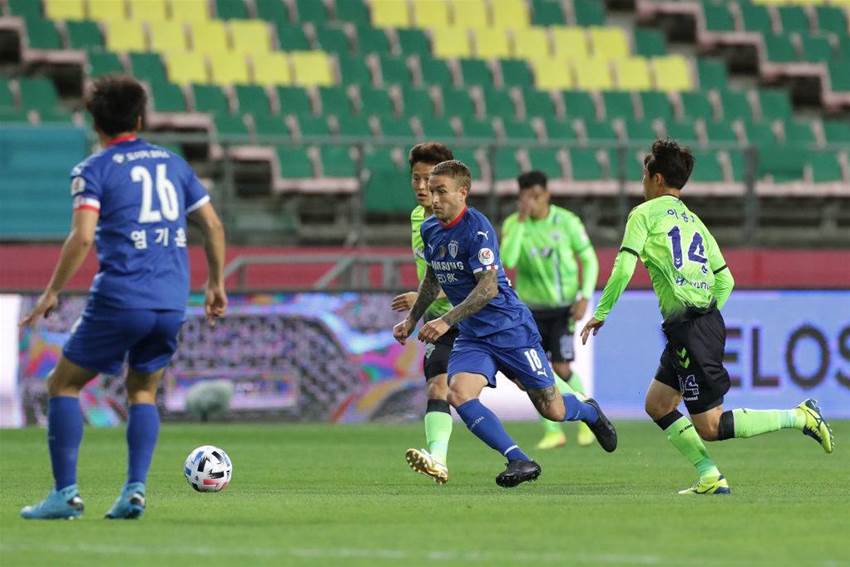For 15 years, Simon Hill traversed the world as a TV commentator covering the Socceroos in gantries from Riyadh to Rotterdam. But a live stream was something new.
Logged in to Grabyo’s Producer software - and in touch with a small team of Grabyo production staff in remote locations - the respected broadcaster commentated last Friday night's K-League 1 live stream between Suwon Bluewings and Jeonbuk Motors.
A large audience on Twitter and YouTube watched the live stream as his expert commentary described the action at the Jeonju World Cup Stadium.
"I really enjoyed it. And the huge numbers on Twitter watching the live stream seemed to enjoy it too,” Hill told FTBL.
“It was really different calling a game in another country from my front room.
“And to be honest, doing the live stream was a really positive experience all-round."
Robust remote technology, a live stream together with human creativity all worked together to bring a live-sport hungry viewership what it craved - albeit COVID-19 style (empty stadium, face masks, and social distancing protocols) but all at a fraction of a linear broadcast cost.
"The most important takeaway from the match was that K-League put together a blueprint that could help other sports start to get going again,” Marcello Fabiano, Head of Grabyo in Australia and New Zealand, explains.
"Traditional hardware and software-based tools weren’t designed for the needs of digital platforms. Cloud technology is helping producers take the tools they need and helping them to create content more quickly and efficiently.
"Remote productions will likely become the new normal. You don’t need to send lots of equipment and personnel to broadcast a live event from the other side of the world.
"The cost and time savings are more evident now than they ever have been.
"The viewership was very positive, and it will only continue to grow as more matches are delivered to social and digital platforms.”
Certainly, COVID-19 has opened up the conversation about broadcast costs with remote video production companies like Grabyo at the vanguard of OTT (over the top broadcasting).
NPL competitions - Australia’s semi-pro second tier - have already twigged that a live stream of their leagues is a savvy broadcast solution for their under-publicized competitions.
With remote production capability and SAAS (Software As A Service) like LIGR.live for in-game graphics, it is a budget-friendly way for smaller sports organizations to showcase their teams, players, and, importantly, sponsors within a live stream.
What is clear is that, as you’d expect, there’s a boom in live streaming.
Live-stream users reached 560 million in China as of March this year, an uptick of 163 million users since 2018.
Live stream talk shows, cooking shows, lifestyle shows, you name it, it’s being streamed right now as brands cleverly adapt their content marketing strategies.
For instance, reported figures from the China Internet Network Information Centre point to year on year growth in live stream analytics.
The number of live-streaming users reached 560 million in China as of March this year, an uptick of 163 million users since 2018.
And globally, gaming live is going through the roof, with Twitch leading the charge. The gaming live-streaming sector grew 45% between March and April this year (according to Arsenal and StreamElement’s monthly report).
The industry had 3.934 billion hours of live streams watched across Twitch, YouTube Gaming, Facebook Gaming, and Mixer this past month, up from 1.971 billion last April.
Consumers now have a choice: linear TV and set-top boxes or OTT and connected devices. This change is accelerating, and it is forcing publishers and broadcasters to change the way they think about production.
"Many people across the world are staying at home, so providing a place for people to watch live sport for free and communicate, discuss and chat on a social platform will pave the way for more accessible live sport in the future," Fabiano adds.
"Many have come to realize the cloud is not only very flexible but robust. There is no longer the trade-off of quality when switching from traditional tools to cloud production."
Fabiano notes remote technological innovation, a live stream, and human quality combined as well as Jeonbuk Motors for its winning goal in the 1-0 victory last Friday night.
"It was a huge coup to have Simon calling the live stream. Alongside being a top commentator and presenter, he’s a great advocate of innovation.
"He did an amazing job which gave the live stream greater depth and quality."
Related Articles
.jpeg&h=172&w=306&c=1&s=1)
Socceroos prodigy returns to A-League after horror run

Star keeper's exit heralds hero's return at A-League giant












